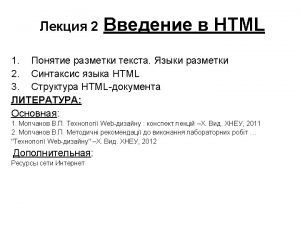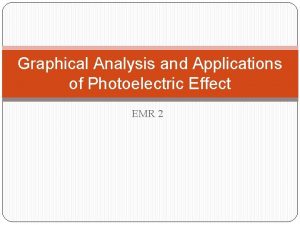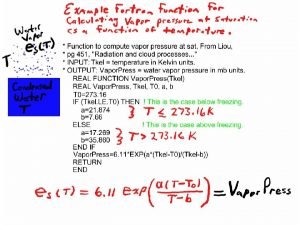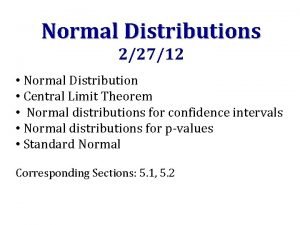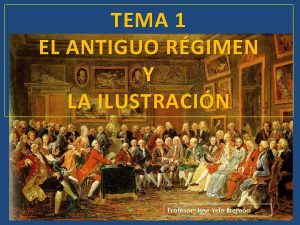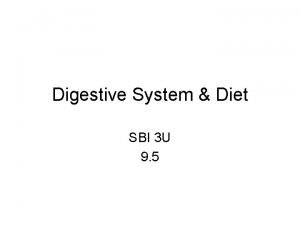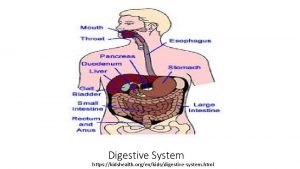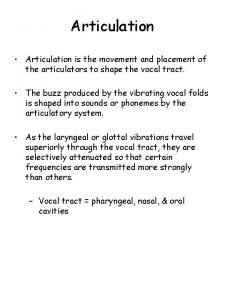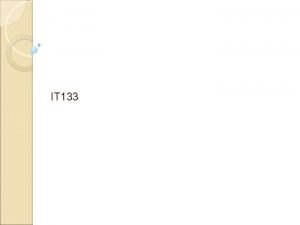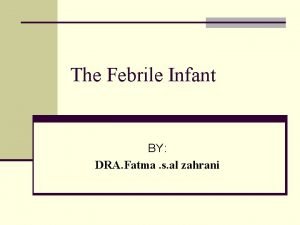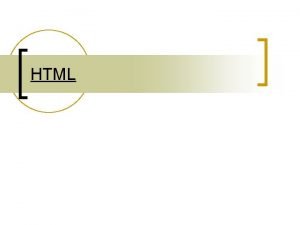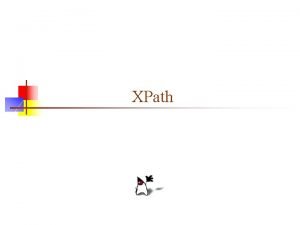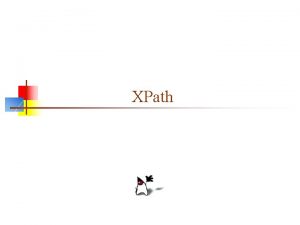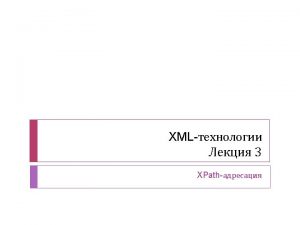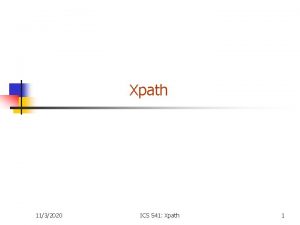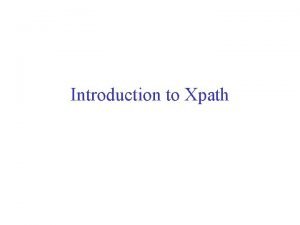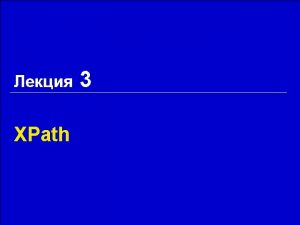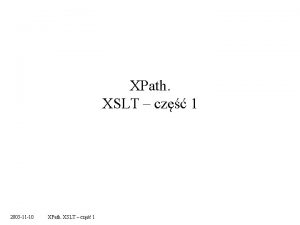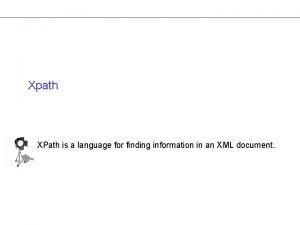XPATH http www zvon orgxxlXPath TutorialGe neralexamples html










![• /AAA/BBB[last()] • Select the last BBB child of element AAA • <AAA> • /AAA/BBB[last()] • Select the last BBB child of element AAA • <AAA>](https://slidetodoc.com/presentation_image_h2/86ab4aa03cf888ef1e6d2a9babcc358b/image-11.jpg)

![• //BBB[@id] • Select BBB elements which have attribute id • <AAA> <BBB • //BBB[@id] • Select BBB elements which have attribute id • <AAA> <BBB](https://slidetodoc.com/presentation_image_h2/86ab4aa03cf888ef1e6d2a9babcc358b/image-13.jpg)
![• //BBB[@name] • Select BBB elements which have attribute name • <AAA> <BBB • //BBB[@name] • Select BBB elements which have attribute name • <AAA> <BBB](https://slidetodoc.com/presentation_image_h2/86ab4aa03cf888ef1e6d2a9babcc358b/image-14.jpg)
![• //BBB[@*] • Select BBB elements which have any attribute • <AAA> <BBB • //BBB[@*] • Select BBB elements which have any attribute • <AAA> <BBB](https://slidetodoc.com/presentation_image_h2/86ab4aa03cf888ef1e6d2a9babcc358b/image-15.jpg)
![• //BBB[not(@*)] • Select BBB elements without an attribute • <AAA> <BBB id • //BBB[not(@*)] • Select BBB elements without an attribute • <AAA> <BBB id](https://slidetodoc.com/presentation_image_h2/86ab4aa03cf888ef1e6d2a9babcc358b/image-16.jpg)
![• Values of attributes can be used as selection criteria. . //BBB[@id='b 1'] • Values of attributes can be used as selection criteria. . //BBB[@id='b 1']](https://slidetodoc.com/presentation_image_h2/86ab4aa03cf888ef1e6d2a9babcc358b/image-17.jpg)
![• //BBB[@name='bbb'] • Select BBB elements which have attribute name with value 'bbb' • //BBB[@name='bbb'] • Select BBB elements which have attribute name with value 'bbb'](https://slidetodoc.com/presentation_image_h2/86ab4aa03cf888ef1e6d2a9babcc358b/image-18.jpg)

![• Function count() counts the number of selected elements • //*[count(BBB)=2] • Select • Function count() counts the number of selected elements • //*[count(BBB)=2] • Select](https://slidetodoc.com/presentation_image_h2/86ab4aa03cf888ef1e6d2a9babcc358b/image-20.jpg)
![• //*[count(*)=2] • Select elements which have 2 children • <AAA> <CCC> <BBB/> • //*[count(*)=2] • Select elements which have 2 children • <AAA> <CCC> <BBB/>](https://slidetodoc.com/presentation_image_h2/86ab4aa03cf888ef1e6d2a9babcc358b/image-21.jpg)
![• //*[count(*)=3] • Select elements which have 3 children • <AAA> <CCC> <BBB/> • //*[count(*)=3] • Select elements which have 3 children • <AAA> <CCC> <BBB/>](https://slidetodoc.com/presentation_image_h2/86ab4aa03cf888ef1e6d2a9babcc358b/image-22.jpg)
![• //*[name()='BBB'] • Select all elements with name BBB, equivalent with //BBB • • //*[name()='BBB'] • Select all elements with name BBB, equivalent with //BBB •](https://slidetodoc.com/presentation_image_h2/86ab4aa03cf888ef1e6d2a9babcc358b/image-23.jpg)
![• //*[starts-with(name(), 'B')] • Select all elements name of which starts with letter • //*[starts-with(name(), 'B')] • Select all elements name of which starts with letter](https://slidetodoc.com/presentation_image_h2/86ab4aa03cf888ef1e6d2a9babcc358b/image-24.jpg)
![• //*[contains(name(), 'C')] • Select all elements name of which contain letter C • //*[contains(name(), 'C')] • Select all elements name of which contain letter C](https://slidetodoc.com/presentation_image_h2/86ab4aa03cf888ef1e6d2a9babcc358b/image-25.jpg)
![• //*[string-length(name()) = 3] • Select elements with three-letter name • <AAA> <Q/> • //*[string-length(name()) = 3] • Select elements with three-letter name • <AAA> <Q/>](https://slidetodoc.com/presentation_image_h2/86ab4aa03cf888ef1e6d2a9babcc358b/image-26.jpg)
![• //*[string-length(name()) < 3] • Select elements name of which has one or • //*[string-length(name()) < 3] • Select elements name of which has one or](https://slidetodoc.com/presentation_image_h2/86ab4aa03cf888ef1e6d2a9babcc358b/image-27.jpg)
![• //*[string-length(name()) > 3] • Select elements with name longer than three characters • //*[string-length(name()) > 3] • Select elements with name longer than three characters](https://slidetodoc.com/presentation_image_h2/86ab4aa03cf888ef1e6d2a9babcc358b/image-28.jpg)











- Slides: 39

XPATH http: //www. zvon. org/xxl/XPath. Tutorial/Ge neral/examples. html

• XPath syntax is similar to file system. If the path starts with the slash / , then it represents an absolute path to the required element. • /AAA (Select the root element AAA) • <AAA> <BBB/> <CCC/> <BBB/> <DDD> <BBB/> </DDD> <CCC/> </AAA>

• /AAA/CCC • Select all elements CCC which are children of the root element AAA • <AAA> <BBB/> <CCC/> <BBB/> <DDD> <BBB/> </DDD> <CCC/> </AAA>

• /AAA/DDD/BBB • Select all elements BBB which are children of DDD which are children of the root element AAA • <AAA> <BBB/> <CCC/> <BBB/> <DDD> <BBB/> </DDD> <CCC/> </AAA>

• If the path starts with // then all elements in the document which fulfill following criteria are selected. • //BBB • Select all elements BBB • <AAA> <BBB/> <CCC/> <BBB/> <DDD> <BBB/> </DDD> <CCC> <DDD> <BBB/> </DDD> </CCC> </AAA>

• //DDD/BBB • Select all elements BBB which are children of DDD • <AAA> <BBB/> <CCC/> <BBB/> <DDD> <BBB/> </DDD> <CCC> <DDD> <BBB/> </DDD> </CCC> </AAA>

• The star * selects all elements located by preceeding path /AAA/CCC/DDD/* • Select all elements enclosed by elements /AAA/CCC/DDD • <AAA> • <XXX> <DDD> <BBB/> <EEE/> <FFF/> </DDD> </XXX> <CCC> <DDD> <BBB/> <EEE/> <FFF/> </DDD> • </CCC> <BBB> <BBB/> </BBB> </CCC> </AAA>

• /*/*/*/BBB • Select all elements BBB which have 3 ancestors • <AAA> <XXX> <DDD> <BBB/> <EEE/> <FFF/> </DDD> </XXX> <CCC> • <DDD> <BBB/> <EEE/> <FFF/> </DDD> </CCC> <BBB> <BBB/> </BBB> </CCC> </AAA>

• //* • Select all elements • <AAA> <XXX> <DDD> <BBB/> <EEE/> <FFF/> </DDD> </XXX> <CCC> <DDD> • <BBB/> <EEE/> <FFF/> </DDD> </CCC> <BBB> <BBB/> </BBB> </CCC> </AAA>

• Expression in square brackets can further specify an element. A number in the brackets gives the position of the element in the selected set. The function last() selects the last element in the selection. /AAA/BBB[1] • Select the first BBB child of element AAA • <AAA> <BBB/> </AAA>
![AAABBBlast Select the last BBB child of element AAA AAA • /AAA/BBB[last()] • Select the last BBB child of element AAA • <AAA>](https://slidetodoc.com/presentation_image_h2/86ab4aa03cf888ef1e6d2a9babcc358b/image-11.jpg)
• /AAA/BBB[last()] • Select the last BBB child of element AAA • <AAA> <BBB/> </AAA>

• Attributes are specified by @ prefix. • //@id • Select all attributes @id • <AAA> <BBB id = "b 1"/> <BBB id = "b 2"/> <BBB name = "bbb"/> <BBB/> </AAA>
![BBBid Select BBB elements which have attribute id AAA BBB • //BBB[@id] • Select BBB elements which have attribute id • <AAA> <BBB](https://slidetodoc.com/presentation_image_h2/86ab4aa03cf888ef1e6d2a9babcc358b/image-13.jpg)
• //BBB[@id] • Select BBB elements which have attribute id • <AAA> <BBB id = "b 1"/> <BBB id = "b 2"/> <BBB name = "bbb"/> <BBB/> </AAA>
![BBBname Select BBB elements which have attribute name AAA BBB • //BBB[@name] • Select BBB elements which have attribute name • <AAA> <BBB](https://slidetodoc.com/presentation_image_h2/86ab4aa03cf888ef1e6d2a9babcc358b/image-14.jpg)
• //BBB[@name] • Select BBB elements which have attribute name • <AAA> <BBB id = "b 1"/> <BBB id = "b 2"/> <BBB name = "bbb"/> <BBB/> </AAA>
![BBB Select BBB elements which have any attribute AAA BBB • //BBB[@*] • Select BBB elements which have any attribute • <AAA> <BBB](https://slidetodoc.com/presentation_image_h2/86ab4aa03cf888ef1e6d2a9babcc358b/image-15.jpg)
• //BBB[@*] • Select BBB elements which have any attribute • <AAA> <BBB id = "b 1"/> <BBB id = "b 2"/> <BBB name = "bbb"/> <BBB/> </AAA>
![BBBnot Select BBB elements without an attribute AAA BBB id • //BBB[not(@*)] • Select BBB elements without an attribute • <AAA> <BBB id](https://slidetodoc.com/presentation_image_h2/86ab4aa03cf888ef1e6d2a9babcc358b/image-16.jpg)
• //BBB[not(@*)] • Select BBB elements without an attribute • <AAA> <BBB id = "b 1"/> <BBB id = "b 2"/> <BBB name = "bbb"/> <BBB/> </AAA>
![Values of attributes can be used as selection criteria BBBidb 1 • Values of attributes can be used as selection criteria. . //BBB[@id='b 1']](https://slidetodoc.com/presentation_image_h2/86ab4aa03cf888ef1e6d2a9babcc358b/image-17.jpg)
• Values of attributes can be used as selection criteria. . //BBB[@id='b 1'] • Select BBB elements which have attribute id with value b 1 • <AAA> <BBB id = "b 1"/> <BBB name = " bbb "/> <BBB name = "bbb"/> </AAA>
![BBBnamebbb Select BBB elements which have attribute name with value bbb • //BBB[@name='bbb'] • Select BBB elements which have attribute name with value 'bbb'](https://slidetodoc.com/presentation_image_h2/86ab4aa03cf888ef1e6d2a9babcc358b/image-18.jpg)
• //BBB[@name='bbb'] • Select BBB elements which have attribute name with value 'bbb' • <AAA> <BBB id = "b 1"/> <BBB name = " bbb "/> <BBB name = "bbb"/> </AAA>

• Normalized-space removes leading and starting spaces and replaces sequences of whitespace characters by a single space • //BBB[normalize-space(@name)='bbb'] • Select BBB elements which have attribute name with value bbb, leading and trailing spaces are removed before comparison • <AAA> <BBB id = "b 1"/> <BBB name = " bbb "/> <BBB name = "bbb"/> </AAA>
![Function count counts the number of selected elements countBBB2 Select • Function count() counts the number of selected elements • //*[count(BBB)=2] • Select](https://slidetodoc.com/presentation_image_h2/86ab4aa03cf888ef1e6d2a9babcc358b/image-20.jpg)
• Function count() counts the number of selected elements • //*[count(BBB)=2] • Select elements which have two children BBB • <AAA> <CCC> <BBB/> </CCC> <DDD> <BBB/> </DDD>
![count2 Select elements which have 2 children AAA CCC BBB • //*[count(*)=2] • Select elements which have 2 children • <AAA> <CCC> <BBB/>](https://slidetodoc.com/presentation_image_h2/86ab4aa03cf888ef1e6d2a9babcc358b/image-21.jpg)
• //*[count(*)=2] • Select elements which have 2 children • <AAA> <CCC> <BBB/> </CCC> <DDD> <BBB/> </DDD> <EEE> <CCC/> <DDD/> </EEE> </AAA>
![count3 Select elements which have 3 children AAA CCC BBB • //*[count(*)=3] • Select elements which have 3 children • <AAA> <CCC> <BBB/>](https://slidetodoc.com/presentation_image_h2/86ab4aa03cf888ef1e6d2a9babcc358b/image-22.jpg)
• //*[count(*)=3] • Select elements which have 3 children • <AAA> <CCC> <BBB/> </CCC> <DDD> <BBB/> </DDD> <EEE> <CCC/> <DDD/> </EEE> </AAA>
![nameBBB Select all elements with name BBB equivalent with BBB • //*[name()='BBB'] • Select all elements with name BBB, equivalent with //BBB •](https://slidetodoc.com/presentation_image_h2/86ab4aa03cf888ef1e6d2a9babcc358b/image-23.jpg)
• //*[name()='BBB'] • Select all elements with name BBB, equivalent with //BBB • <AAA> <BCC> <BBB/> </BCC> <DDB> <BBB/> </DDB>
![startswithname B Select all elements name of which starts with letter • //*[starts-with(name(), 'B')] • Select all elements name of which starts with letter](https://slidetodoc.com/presentation_image_h2/86ab4aa03cf888ef1e6d2a9babcc358b/image-24.jpg)
• //*[starts-with(name(), 'B')] • Select all elements name of which starts with letter B • <AAA> <BCC> <BBB/> </BCC> <DDB> <BBB/> </DDB> <BEC> <CCC/> <DBD/> </BEC> </AAA>
![containsname C Select all elements name of which contain letter C • //*[contains(name(), 'C')] • Select all elements name of which contain letter C](https://slidetodoc.com/presentation_image_h2/86ab4aa03cf888ef1e6d2a9babcc358b/image-25.jpg)
• //*[contains(name(), 'C')] • Select all elements name of which contain letter C • <AAA> <BCC> <BBB/> </BCC> <DDB> <BBB/> </DDB> <BEC> <CCC/> <DBD/> </BEC> </AAA>
![stringlengthname 3 Select elements with threeletter name AAA Q • //*[string-length(name()) = 3] • Select elements with three-letter name • <AAA> <Q/>](https://slidetodoc.com/presentation_image_h2/86ab4aa03cf888ef1e6d2a9babcc358b/image-26.jpg)
• //*[string-length(name()) = 3] • Select elements with three-letter name • <AAA> <Q/> <SSSS/> <BB/> <CCC/> <DDDD/> <EEEE/> </AAA>
![stringlengthname 3 Select elements name of which has one or • //*[string-length(name()) < 3] • Select elements name of which has one or](https://slidetodoc.com/presentation_image_h2/86ab4aa03cf888ef1e6d2a9babcc358b/image-27.jpg)
• //*[string-length(name()) < 3] • Select elements name of which has one or two characters • <AAA> <Q/> <SSSS/> <BB/> <CCC/> <DDDD/> <EEEE/> </AAA> •
![stringlengthname 3 Select elements with name longer than three characters • //*[string-length(name()) > 3] • Select elements with name longer than three characters](https://slidetodoc.com/presentation_image_h2/86ab4aa03cf888ef1e6d2a9babcc358b/image-28.jpg)
• //*[string-length(name()) > 3] • Select elements with name longer than three characters • <AAA> <Q/> <SSSS/> <BB/> <CCC/> <DDDD/> <EEEE/> </AAA>

• Several paths can be combined with | separator. //CCC | //BBB • Select all elements CCC and BBB • <AAA> <BBB/> <CCC/> <DDD> <CCC/> </DDD> <EEE/> </AAA>

• /AAA/EEE | //BBB • Select all elements BBB and elements EEE which are children of root element AAA • <AAA> <BBB/> <CCC/> <DDD> <CCC/> </DDD> <EEE/> </AAA>

• /AAA/EEE | //DDD/CCC | /AAA | //BBB • Number of combinations is not restricted • <AAA> <BBB/> <CCC/> <DDD> <CCC/> </DDD> <EEE/> </AAA>

• The child axis contains the children of the context node. The child axis is the default axis and it can be omitted. /AAA • Equivalent of /child: : AAA • <AAA> <BBB/> <CCC/> </AAA>

• /AAA/BBB • Equivalent of /child: : AAA/child: : BBB • <AAA> <BBB/> <CCC/> </AAA>

• /child: : AAA/BBB • Both possibilities can be combined • <AAA> <BBB/> <CCC/> </AAA>

• /descendant: : * • Select all descendats of document root and therefore all elements • <AAA> <BBB> <DDD> <CCC> <DDD/> <EEE/> </CCC> </DDD> </BBB>

• /AAA/BBB/descendant: : * • Select all descendants of /AAA/BBB • <AAA> <BBB> <DDD> <CCC> <DDD/> <EEE/> </CCC> </DDD> </BBB

• //CCC/descendant: : * • Select all elements which have CCC among its ancestors • <AAA> <BBB> <DDD> <CCC> <DDD/> <EEE/> </CCC> </DDD> </BBB> <CCC> • <DDD> <EEE> <DDD> <FFF/> </DDD> </EEE> </DDD> </CCC> </AAA>

• //CCC/descendant: : DDD • Select elements DDD which have CCC among its ancestors • <AAA> <BBB> <DDD> <CCC> <DDD/> <EEE/> </CCC> </DDD> </BBB> <CCC> • <DDD> <EEE> <DDD> <FFF/> </DDD> </EEE> </DDD> </CCC> </AAA>

• The parent axis contains the parent of the context node, if there is one. //DDD/parent: : * • Select all parents of DDD element • <AAA> <BBB> <DDD> <CCC> <DDD/> <EEE/> </CCC> </DDD> </BBB> <CCC> <DDD> • <EEE> <DDD> <FFF/> </DDD> </EEE> </DDD> </CCC> </AAA>
 Potapljaški zvon
Potapljaški zvon Org.apache.xpath.xpathapi
Org.apache.xpath.xpathapi Flukeout answers
Flukeout answers Xpath beispiele
Xpath beispiele Xpath root
Xpath root Msxml xpath
Msxml xpath Xpath exercises
Xpath exercises Dom4j xpath
Dom4j xpath Xpath visualizer
Xpath visualizer Slidetodoc.com
Slidetodoc.com 12.html?action=
12.html?action= Doctype html html head
Doctype html html head Canvas доска
Canvas доска 1
1 Individualistic theory of criminality example
Individualistic theory of criminality example Kcvs.ca photoelectric effect
Kcvs.ca photoelectric effect B) http://www.schoolguides.com/types_of_scholarships.html
B) http://www.schoolguides.com/types_of_scholarships.html Slidetodoc
Slidetodoc Http://weather.uwyo.edu/upperair/sounding.html
Http://weather.uwyo.edu/upperair/sounding.html Davidmlane t table
Davidmlane t table Http://geosevillano.blogspot.com/p/blog-page_6.html
Http://geosevillano.blogspot.com/p/blog-page_6.html Digestion 5 steps
Digestion 5 steps Harcourtschool.com/activity/food/food menu.html
Harcourtschool.com/activity/food/food menu.html @arya ia:http://work4unity.in/haicantik.html
@arya ia:http://work4unity.in/haicantik.html Kids health digestive system
Kids health digestive system Metrocosm global migration map
Metrocosm global migration map Uvular
Uvular Dominic jordan
Dominic jordan wix 使い方
wix 使い方 @arya ia:http://work4unity.in/haicantik.html
@arya ia:http://work4unity.in/haicantik.html Http ://stsp.creteil.iufm.fr/article89.html
Http ://stsp.creteil.iufm.fr/article89.html Xenon neutrons
Xenon neutrons @kuanlyna fatma:http://m.2265.com/down/132284.html
@kuanlyna fatma:http://m.2265.com/down/132284.html @katochimotokidoari:http://work4unity.in/haicantik.html
@katochimotokidoari:http://work4unity.in/haicantik.html Http://weather.uwyo.edu/upperair/sounding.html
Http://weather.uwyo.edu/upperair/sounding.html Http //siat.ung.ac.id atau http //pmb.ung.ac.id
Http //siat.ung.ac.id atau http //pmb.ung.ac.id Http //mbs.meb.gov.tr/ http //www.alantercihleri.com
Http //mbs.meb.gov.tr/ http //www.alantercihleri.com Hyper html
Hyper html Html
Html Html
Html









